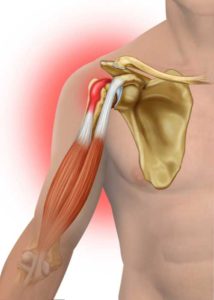Biceps Tendon Tear Specialist

Are you a worker or an athlete who participates in activities that involve heavy overhead lifting? If so, you may be at risk of tearing your biceps tendon. A biceps tendon injury can occur from repetitive overuse, a fall, heavy lifting or degeneration of the tendon over time. Biceps tendon injury specialists, Doctor Riley J. Williams provides diagnosis as well as surgical and nonsurgical treatment options for patients in Manhattan, Brooklyn, New York City and surrounding areas who have sustained an bicepts tendon injury in their shoulder. Contact Dr. Williams’ team today!
What is a biceps tendon tear?
The biceps brachii muscle has two portions that attach at the top of the shoulder and run along the anterior (front) portion of the humerus (upper arm bone). The upper portion of the biceps muscle attaches to the top of the shoulder via two tendons: 1) the long head of the biceps tendon, which passes through the shoulder joint and is directly attached to the superior labrum; and 2) the short head of the biceps tendon which is attached to the coracoid process of the scapula (shoulder blade). The lower (distal) portion of the biceps muscle is attached to one of the forearm bones at the radial tuberosity, a bony prominence located on the forearm just past the elbow. The biceps muscle plays an important role in flexing the elbow and rotating the wrist and forearm. A biceps tendon injury can occur at any of these tendon sites. Dr. Riley J. Williams, orthopedic shoulder specialist serving patients in Manhattan, Brooklyn, New York City, NY and surrounding areas, has the knowledge and understanding, as well as substantial experience in treating patients who have experienced a biceps tendon injury.
Are there different types of biceps tendon tears?
Biceps tendon injuries are classified into two categories based on where the injury is located.
Proximal Biceps Tendon Tear: This type of injury occurs in the shoulder when one of the tendons is torn away from their attachment sites. The long head of the biceps tendon is commonly injured. While some proximal biceps tendon injuries can be severe, these injuries do not always require surgical repair.
Distal Biceps Tendon Tear: This type of injury occurs when the distal biceps tendon is torn away from its attachment site on the radial tuberosity at the elbow. A distal biceps tendon injury is typically seen in weightlifters or those that lift unusually heavy objects as part of their work duties. This injury requires immediate surgical repair to reattach the tendon at the elbow or significant disability will result.
What are the symptoms of a biceps tendon tear?
The most common complaint of a biceps tendon injury is a sharp and sudden pain located at the site of the tear. Other symptoms include:
- Weakness at the shoulder or elbow
- Hearing or feeling a “pop” with the tendon tear
- Bruising of the upper arm or elbow
- Cramping of the upper arm with use of the biceps muscle
- Difficulty rotating the forearm
- “Popeye muscle”: Because the tendon is no longer holding the biceps muscle taught, a visual deformity such as a bulge may be noticed along the anterior portion of the upper arm
How is a biceps tendon tear or injury diagnosed?
Prompt medical attention is recommended if a biceps tendon injury is suspected. Not all types of biceps tendon injuries require surgical repair; however, a distal injury requires immediate surgical intervention. Dr. Williams can diagnose a biceps tendon injury with a comprehensive medical history and physical examination. Diagnostic imaging, including x-rays and magnetic resonance imaging (MRI), may be needed to identify damage to any other structures within the shoulder or forearm.
What is the treatment for a biceps tendon injury?
Non-surgical treatment:
Patients diagnosed with a proximal biceps tendon injury typically recover with conservative treatment. The application of ice and non-steroidal anti-inflammatory medications can reduce the pain and inflammation associated with this injury. Refraining from heavy lifting or other activities involving the upper arm is highly encouraged to promote recovery. Once the pain and inflammation have decreased, Dr. Williams will recommend a physical rehabilitation program aimed at strengthening and restoring range of motion to the shoulder joint.
*Non-surgical treatment is not appropriate for distal biceps tendon tears.
Surgical treatment:
If a patient is experiencing cramping or severe pain, or if conservative therapy is unsuccessful, Dr. Williams may recommend a shoulder arthroscopy with Biceps Tenodesis for proximal biceps tendon injuries. A partial proximal biceps tendon tear may require debridement, a procedure where only the torn or frayed edges of the tendon are removed. A procedure known as biceps tenodesis may be utilized if the tendon is completely torn, or a large portion of the tendon is torn. This procedure removes the damaged portion of the tendon from the shoulder joint and then reattaching the remaining tendon to the humerus. The small incisions employed with the arthroscopic approach allow patients to return to their normal activities in a shorter period of time.
Distal biceps tendon tears require open surgical repair. A small incision is made at the anterior elbow, and the tendon is reattached to the radius using specialized instruments called suture anchors.
For more information on a biceps tendon injury, shoulder pain, or the excellent treatment options available, please contact the office of Dr. Riley J. Williams, an orthopedic shoulder specialist serving Manhattan, Brooklyn, New York City, NY and surrounding areas.
